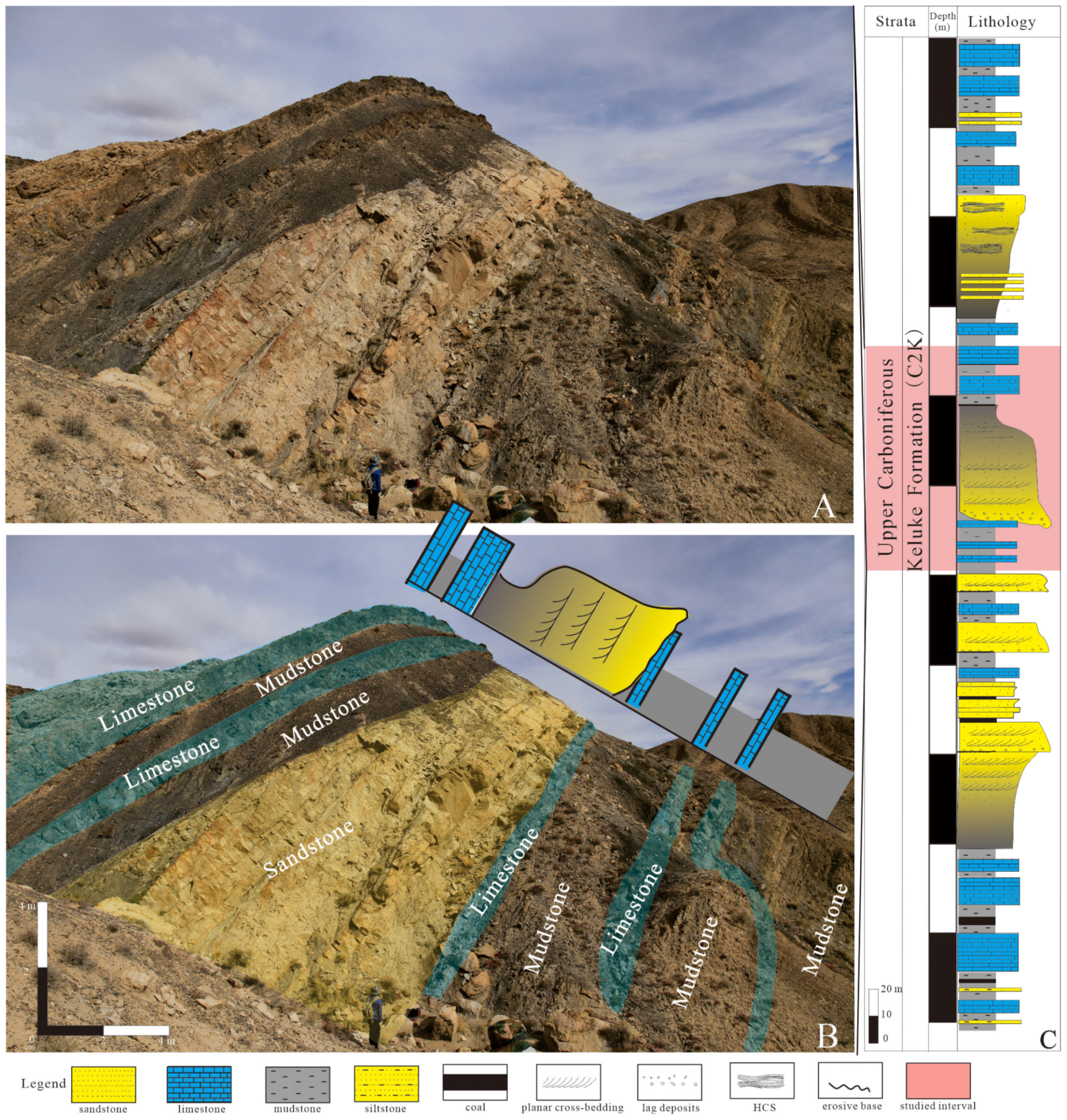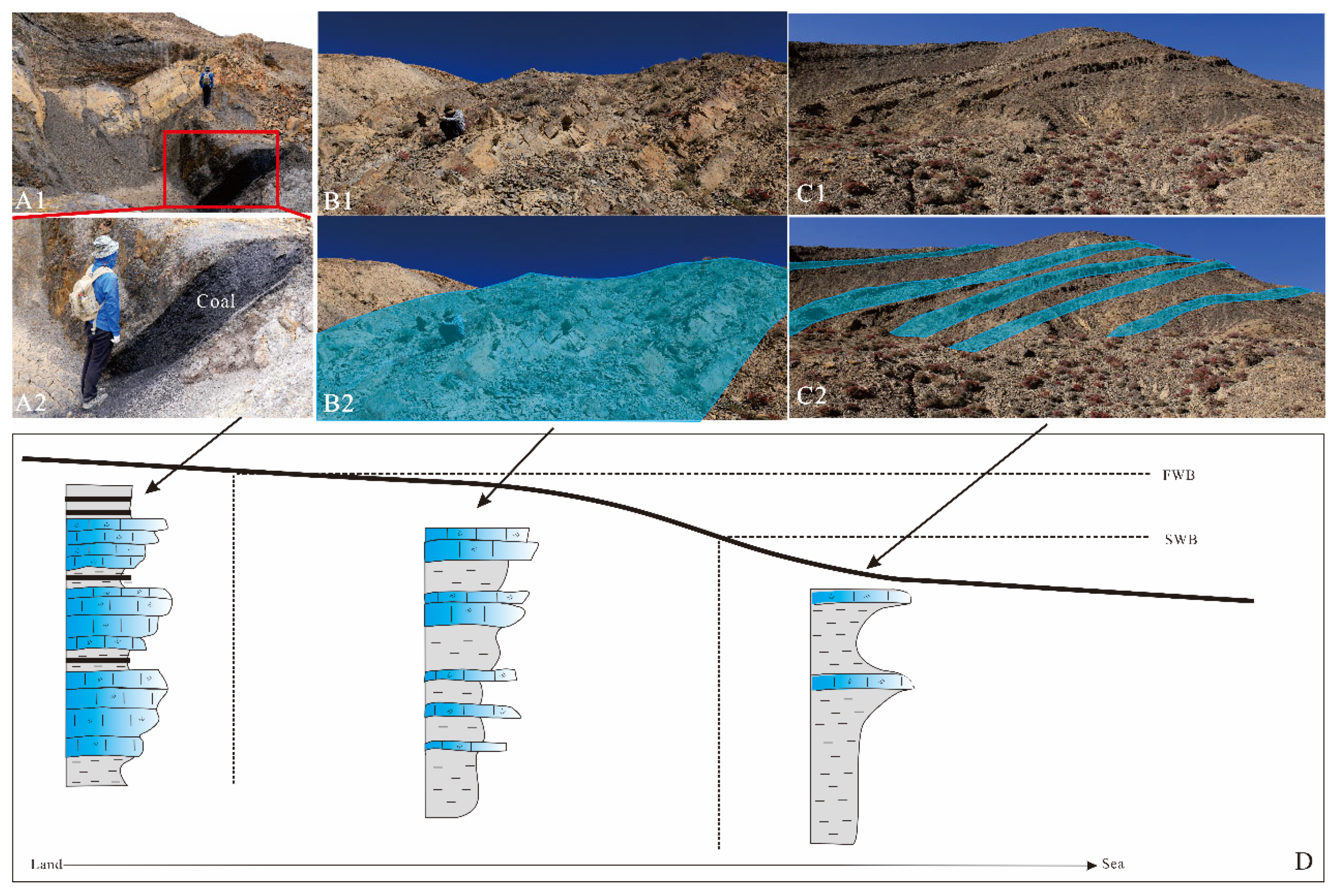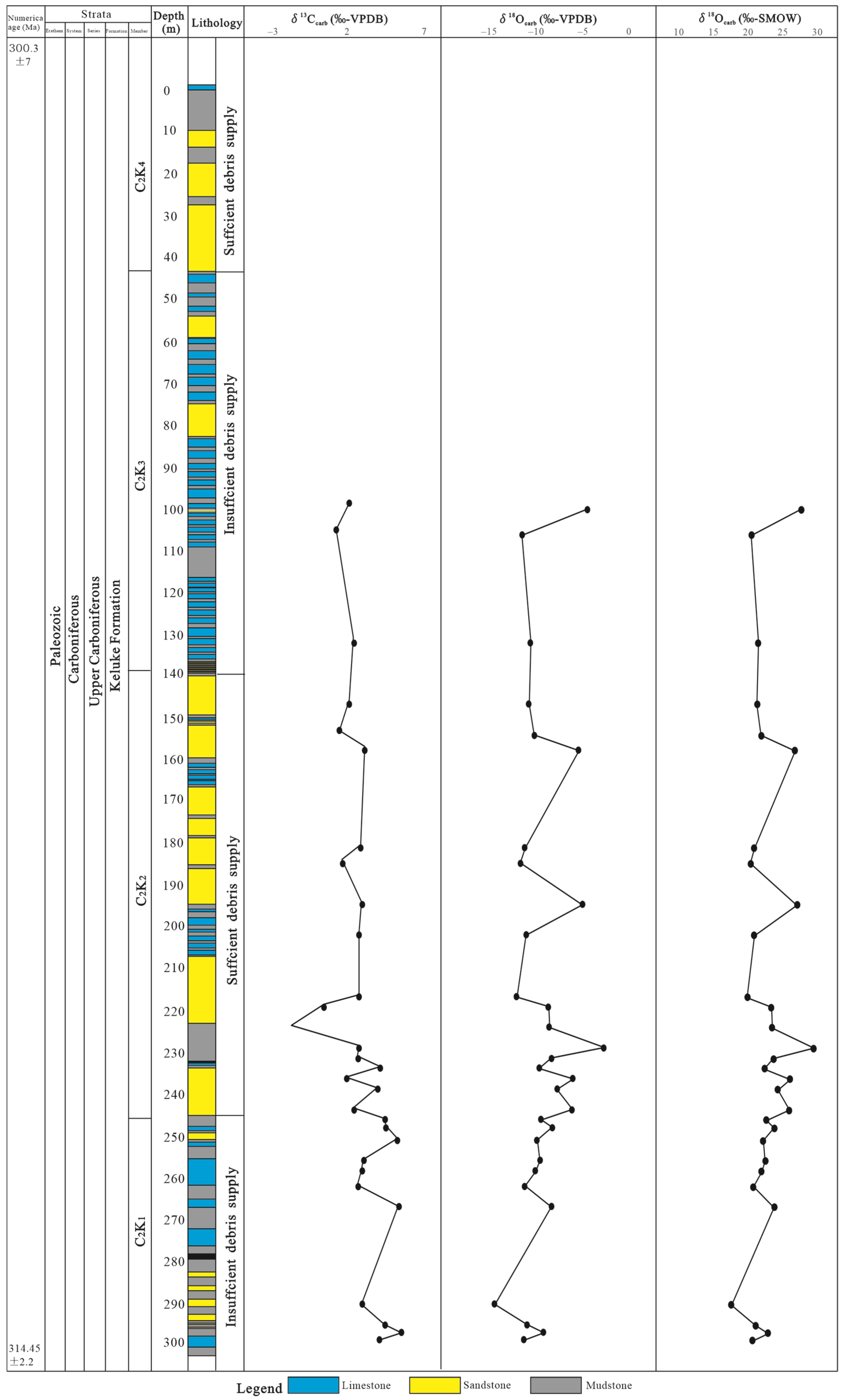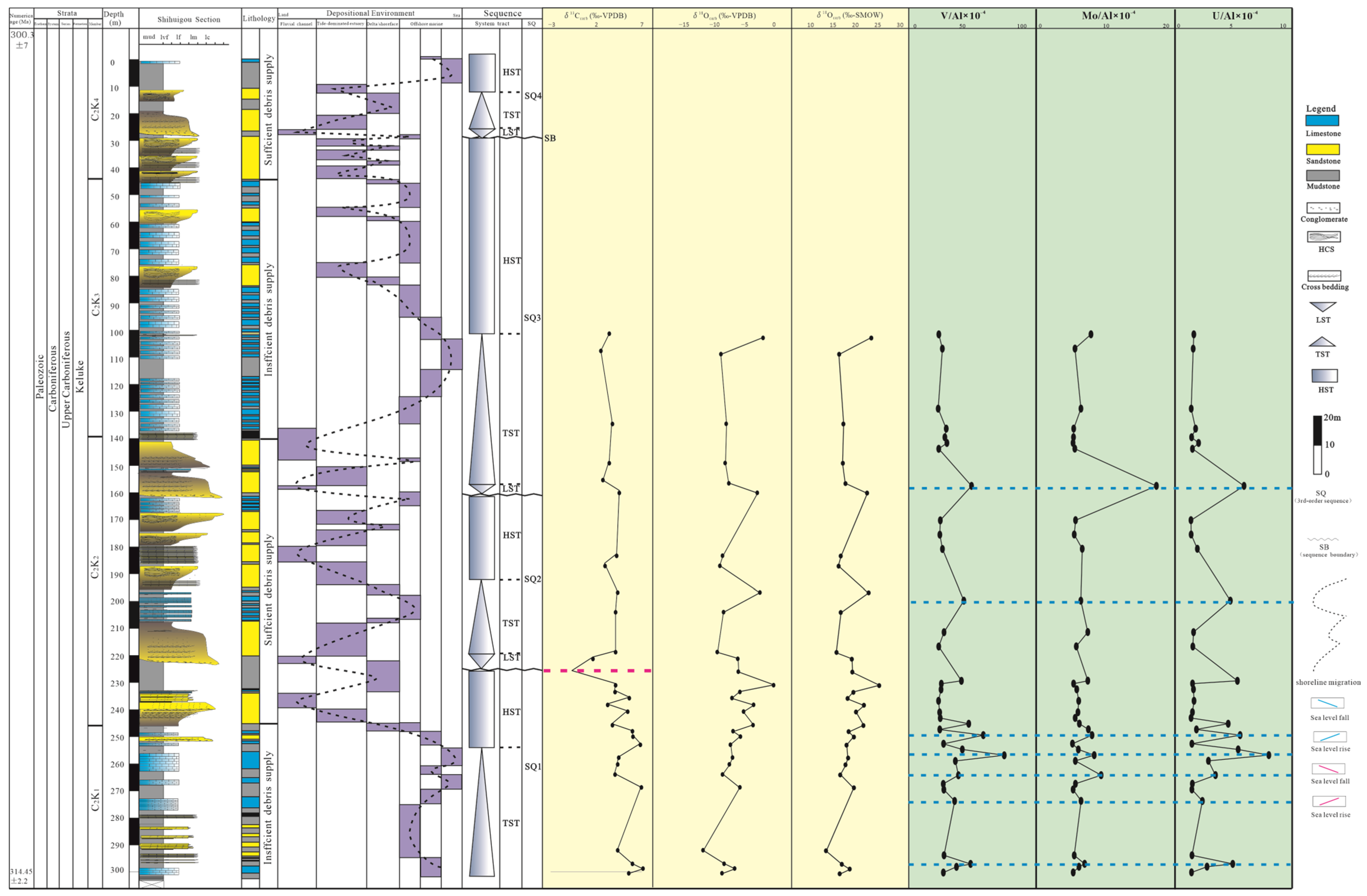Sequence Stratigraphic and Geochemical Records of Paleo-Sea Level Changes in Upper Carboniferous Mixed Clastic–Carbonate Successions in the Eastern Qaidam Basin
Abstract
1. Introduction
2. Geological Setting and Stratigraphy
2.1. Tectonic Background
2.2. Structural Evolution
2.3. Stratigraphy
2.4. Paleoclimatic and Tectonic Controls
3. Database and Methodology
3.1. Sample and Data Collection
3.2. Depositional Environment Analysis
3.3. Sequence Stratigraphic Framework
3.4. Carbon and Oxygen Isotope Analysis
3.5. Integrated Sea Level Reconstruction
4. Results
4.1. Sedimentary and Sequence Stratigraphic Characteristics
4.1.1. Facies Association and Interpretation
Facies Association 1: Fluvial Channels
Facies Association 2: Tide-Dominated Estuary
Facies Association 3: Tide-Influenced Delta
Facies Association 4: Wave-Dominated Shoreface
Facies Association 5: Carbonate-Dominated Shallow Marine
4.1.2. Sequence Stratigraphy Framework
Sequence Boundary and (Maximum) Transgressive Surface
System Tracts and Third-Order Sequences
4.2. Geochemical Characteristics
4.2.1. Carbon and Oxygen Isotope Characteristics
4.2.2. Elemental Geochemical Characteristics
5. Discussion
5.1. Sequence Development in Relation to Sea Level Changes
5.2. Geochemical Record of Sea Level Changes
5.3. Sedimentological and Geochemical Records of Sea Level Changes
5.4. Origins of Mixed Clastic–Carbonate Cycles in the Eastern Qaidam Basin
6. Conclusions
Author Contributions
Funding
Data Availability Statement
Acknowledgments
Conflicts of Interest
References
- Tucker, M.E. Mixed clastic–carbonate cycles and sequences: Quaternary of Egypt and Carboniferous of England. Geol. Croat. 2003, 56, 19–37. [Google Scholar] [CrossRef]
- Coffey, B.P.; Read, J.F. Mixed carbonate–siliciclastic sequence stratigraphy of a Paleogene transition zone continental shelf, southeastern USA. Sediment. Geol. 2004, 166, 21–57. [Google Scholar] [CrossRef]
- Seyedmehdi, Z.; George, A.D.; Tucker, M.E. Sequence development of a latest Devonian–Tournaisian distally-steepened mixed carbonate–siliciclastic ramp, Canning Basin, Australia. Sediment. Geol. 2016, 333, 164–183. [Google Scholar] [CrossRef]
- Eriksson, K.A.; McClung, W.S.; Simpson, E.L. Sequence stratigraphic expression of greenhouse, transitional and icehouse conditions in siliciclastic successions: Paleozoic examples from the central Appalachian basin, USA. Earth Sci. Rev. 2019, 188, 176–189. [Google Scholar] [CrossRef]
- Rygel, M.C.; Fielding, C.R.; Frank, T.D.; Birgenheier, L.P. The magnitude of Late Paleozoic glacioeustatic fluctuations: A synthesis. J. Sediment. Res. 2008, 78, 500–511. [Google Scholar] [CrossRef]
- Garrett, E.; Barlow, N.L.M.; Cool, H.; Kaufman, D.S.; Shennan, I.; Zander, P.D. Constraints on regional drivers of relative sea-level change around Cordova, Alaska. Quat. Sci. Rev. 2015, 113, 48–59. [Google Scholar] [CrossRef]
- Rankey, E.C. Relations between relative changes in sea level and climate shifts: Pennsylvanian–Permian mixed carbonate-siliciclastic strata, western United States. Geol. Soc. Am. Bull. 1997, 109, 1089–1100. [Google Scholar] [CrossRef]
- Isaack, A.; Gischler, E.; Hudson, J.H.; Anselmetti, F.S.; Lohner, A.; Vogel, H.; Garbode, E.; Camoin, G.F. A new model evaluating Holocene sediment dynamics: Insights from a mixed carbonate–siliciclastic lagoon (Bora Bora, Society Islands, French Polynesia, South Pacific). Sediment. Geol. 2016, 343, 99–118. [Google Scholar] [CrossRef]
- Emerson, S.; Hedges, J. Chemical Oceanography and the Marine Carbon Cycle; Cambridge University Press: Cambridge, UK, 2008. [Google Scholar]
- Li, Y.; Zhang, T.; Ellis, G.S.; Shao, D. Depositional environment and organic matter accumulation of Upper Ordovician–Lower Silurian marine shale in the Upper Yangtze Platform, South China. Palaeogeogr. Palaeoclimatol. Palaeoecol. 2017, 466, 252–264. [Google Scholar] [CrossRef]
- Morford, J.L.; Emerson, S. The geochemistry of redox sensitive trace metals in sediments. Geochim. et Cosmochim. Acta 1999, 63, 1735–1750. [Google Scholar] [CrossRef]
- Algeo, T.J.; Lyons, T.W. Mo–total organic carbon covariation in modern anoxic marine environments: Implications for analysis of paleoredox and paleohydrographic conditions. Paleoceanography 2006, 21, 1–23. [Google Scholar] [CrossRef]
- Tribovillard, N.; Algeo, T.J.; Lyons, T.; Riboulleau, A. Trace metals as paleoredox and paleoproductivity proxies: An update. Chem. Geol. 2006, 232, 12–32. [Google Scholar] [CrossRef]
- Plint, A.G. High-frequency relative sea-level oscillations in Upper Cretaceous shelf clastics of the Alberta foreland basin: Possible evidence for a glacio-eustatic control? Sediment. Tecton. Eustasy Sea-Level Changes Act. Margins 1991, 409–428. [Google Scholar] [CrossRef]
- Liu, K.; Li, Z.; Shi, X.; Wei, X.; Ren, Z.; Yang, X.; Peng, B. Late Hercynian-Indosinian denudation and uplift history in the eastern Qaidam Basin: Constraints from multiple thermometric indicators and sedimentary evidences. Chin. J. Geophys. 2020, 63, 1403–1421. (In Chinese) [Google Scholar]
- Chen, S.; Bi, M.; Sun, J.; Zhang, Y.; Zhuang, Y. Mixed sedimentary characteristics and controlling factors of Upper Paleozoic Group in Northern Qaidam Basin. Geol. Bull. China 2016, 35, 282–292. [Google Scholar]
- Yin, A.; Harrison, T.M. Geologic evolution of the Himalayan-Tibetan orogen. Annu. Rev. Earth Planet. Sci. 2000, 28, 211–280. [Google Scholar] [CrossRef]
- Tapponnier, P.; Zhiqin, X.; Roger, F.; Meyer, B.; Arnaud, N.; Wittlinger, G.; Jingsui, Y. Oblique stepwise rise and growth of the Tibet Plateau. Science 2001, 294, 1671–1677. [Google Scholar] [CrossRef]
- Fielding, C.R.; Frank, T.D.; Isbell, J.L. The late Paleozoic ice age—A review of current understanding and synthesis of global climate patterns. In Special Paper 441: Resolving the Late Paleozoic Ice Age in Time and Space; Geological Society of America Special Publication: Boulder, CO, USA, 2008. [Google Scholar]
- Isbell, J.L.; Henry, L.C.; Gulbranson, E.L.; Limarino, C.O.; Fraiser, M.L.; Koch, Z.J.; Ciccioli, P.L.; Dineen, A.A. Glacial paradoxes during the late Paleozoic ice age: Evaluating the equilibrium line altitude as a control on glaciation. Gondwana Res. 2012, 22, 1–19. [Google Scholar] [CrossRef]
- Metcalfe, I. Gondwana dispersion and Asian accretion: Tectonic and palaeogeographic evolution of eastern Tethys. J. Asian Earth Sci. 2013, 66, 1–33. [Google Scholar] [CrossRef]
- Torsvik, T.H.; Cocks, L.R.M. Earth History and Palaeogeography; Cambridge University Press: Cambridge, UK, 2017. [Google Scholar]
- Heckel, P.H. Pennsylvanian cyclothems in Midcontinent North America as far-field effects of waxing and waning of Gondwana ice sheets. In Special Paper 441: Resolving the Late Paleozoic Ice Age in Time and Space; Geological Society of America Special Publication: Boulder, CO, USA, 2008. [Google Scholar]
- Dalrymple, R.W. Tidal depositional systems. In Facies Models Response to Sea-Level Change; Geological Association of Canada: St. John’s, NL, Canada, 1992; pp. 195–218. [Google Scholar]
- Reineck, H.-E.; Singh, I.B. Depositional Sedimentary Environments: With Reference to Terrigenous Clastics; Springer Science & Business Media: Berlin/Heidelberg, Germany, 2012. [Google Scholar]
- Wachter, E.A.; Hayes, J.M. Exchange of oxygen isotopes in carbon dioxide-phosporic acid systems. Chem. Geol. Isot. Geosci. Sect. 1985, 52, 365–374. [Google Scholar] [CrossRef]
- Catuneanu, O.; Abreu, V.; Bhattacharya, J.P.; Blum, M.D.; Dalrymple, R.W.; Eriksson, P.G.; Fielding, C.R.; Fisher, W.L.; Galloway, W.E.; Gibling, M.R.; et al. Towards the standardization of sequence stratigraphy. Earth Sci. Rev. 2009, 92, 1–33. [Google Scholar] [CrossRef]
- Van Wagoner, J.C.; Mitchum, R.M.; Campion, K.M.; Rahmanian, V.D. Siliciclastic Sequence Stratigraphy in Well Logs, Cores, and Outcrops: Concepts for High-Resolution Correlation of Time and Facies; American Association of Petroleum Geologists: Tulsa, OK, USA, 1990. [Google Scholar]
- Sarg, J. Carbonate Sequence Stratigraphy; American Association of Petroleum Geologists: Tulsa, OK, USA, 1988. [Google Scholar]
- Algeo, T.J.; Tribovillard, N. Environmental analysis of paleoceanographic systems based on molybdenum–uranium covariation. Chem. Geol. 2009, 268, 211–225. [Google Scholar] [CrossRef]
- Dalrymple, R.W.; Choi, K. Morphologic and facies trends through the fluvial–marine transition in tide-dominated depositional systems: A schematic framework for environmental and sequence-stratigraphic interpretation. Earth Sci. Rev. 2007, 81, 135–174. [Google Scholar] [CrossRef]
- Dalrymple, R.W.; Zaitlin, B.A. High-resolution sequence stratigraphy of a complex, incised valley succession, Cobequid Bay—Salmon River estuary, Bay of Fundy, Canada. Sedimentology 1994, 41, 1069–1091. [Google Scholar] [CrossRef]
- Owen, G. Experimental soft-sediment deformation: Structures formed by the liquefaction of unconsolidated sands and some ancient examples. Sedimentology 1996, 43, 279–293. [Google Scholar] [CrossRef]
- Ainsworth, R.B.; Vakarelov, B.K.; Eide, C.H.; Howell, J.A.; Bourget, J. Linking the high-resolution architecture of modern and ancient wave-dominated deltas: Processes, products, and forcing factors. J. Sediment. Res. 2019, 89, 168–185. [Google Scholar] [CrossRef]
- Longhitano, S.G.; Mellere, D.; Steel, R.J.; Ainsworth, R.B. Tidal depositional systems in the rock record: A review and new insights. Sediment. Geol. 2012, 279, 2–22. [Google Scholar] [CrossRef]
- Wei, X.; Steel, R.J.; Ravnås, R.; Jiang, Z.; Olariu, C.; Ma, Y. Anatomy of anomalously thick sandstone units in the Brent Delta of the northern North Sea. Sediment. Geol. 2018, 367, 114–134. [Google Scholar] [CrossRef]
- Plink-Björklund, P. Stacked fluvial and tide-dominated estuarine deposits in high-frequency (fourth-order) sequences of the Eocene Central Basin, Spitsbergen. Sedimentology 2005, 52, 391–428. [Google Scholar] [CrossRef]
- Bhattacharya, J.P.; Giosan, L. Wave-influenced deltas: Geomorphological implications for facies reconstruction. Sedimentology 2003, 50, 187–210. [Google Scholar] [CrossRef]
- Dott Jr, R.; Bourgeois, J. Hummocky stratification: Significance of its variable bedding sequences. Geol. Soc. Am. Bull. 1982, 93, 663–680. [Google Scholar] [CrossRef]
- Duke, W.L. Hummocky cross-stratification, tropical hurricanes, and intense winter storms. Sedimentology 1985, 32, 167–194. [Google Scholar] [CrossRef]
- Dumas, S.; Arnott, R. Origin of hummocky and swaley cross-stratification—The controlling influence of unidirectional current strength and aggradation rate. Geology 2006, 34, 1073–1076. [Google Scholar] [CrossRef]
- Wei, X.; Steel, R.J.; Ravnås, R.; Jiang, Z.; Olariu, C.; Li, Z. Variability of tidal signals in the Brent Delta Front: New observations on the Rannoch Formation, northern North Sea. Sediment. Geol. 2016, 335, 166–179. [Google Scholar] [CrossRef]
- Collins, L.B. Sediments and history of the Rottnest Shelf, southwest Australia: A swell-dominated, non-tropical carbonate margin. Sediment. Geol. 1988, 60, 15–49. [Google Scholar] [CrossRef]
- Taylor, S.R.; McLennan, S.M. The Continental Crust: Its Composition and Evolution; Blackwell Scientific Publications: Oxford, UK, 1985. [Google Scholar]
- Li, Y.; Fan, T.; Zhang, J.; Zhang, J.; Wei, X.; Hu, X.; Zeng, W.; Fu, W. Geochemical changes in the Early Cambrian interval of the Yangtze Platform, South China: Implications for hydrothermal influences and paleocean redox conditions. J. Asian Earth Sci. 2015, 109, 100–123. [Google Scholar] [CrossRef]
- Calvert, S.; Pedersen, T. Geochemistry of recent oxic and anoxic marine sediments: Implications for the geological record. Mar. Geol. 1993, 113, 67–88. [Google Scholar] [CrossRef]
- McLennan, S.; Hemming, S.; McDaniel, D.K.; Hanson, G.N. Geochemical approaches to sedimentation, provenance, and tectonics. In Processes Controlling the Composition of Clastic Sediments; Geological Society of America Special Publication: Boulder, CO, USA, 1993. [Google Scholar]
- Li, Y.; Zhang, T.; Shao, D.; Shen, B. New U-Pb zircon age and carbon isotope records from the Lower Silurian Longmaxi Formation on the Yangtze Platform, South China: Implications for stratigraphic correlation and environmental change. Chem. Geol. 2019, 509, 249–260. [Google Scholar] [CrossRef]
- Algeo, T.J.; Maynard, J.B. Trace-element behavior and redox facies in core shales of Upper Pennsylvanian Kansas-type cyclothems. Chem. Geol. 2004, 206, 289–318. [Google Scholar] [CrossRef]
- Helz, G.; Miller, C.V.; Charnock, J.M.; Mosselmans, J.F.W.; Pattrick, R.A.D.; Garner, C.D.; Vaughan, D.J. Mechanism of molybdenum removal from the sea and its concentration in black shales: EXAFS evidence. Geochim. Cosmochim. Acta 1996, 60, 3631–3642. [Google Scholar] [CrossRef]
- Isbell, J.L.; Lenaker, P.A.; Askin, R.A.; Miller, M.F.; Babcock, L.E. Reevaluation of the timing and extent of late Paleozoic glaciation in Gondwana: Role of the Transantarctic Mountains. Geology 2003, 31, 977–980. [Google Scholar] [CrossRef]
- Haq, B.U.; Schutter, S.R. A chronology of Paleozoic sea-level changes. Science 2008, 322, 64–68. [Google Scholar] [CrossRef]











| Sample | Member | Lithology | Depth (m) | δ13Ccarb (‰, VPDB) | δ18Ocarb (‰, VPDB) | V/Al × 10−4 | Mo/Al × 10−4 | U/Al × 10−4 |
|---|---|---|---|---|---|---|---|---|
| shg2016310101 | C2K3 | Mudstone | 298 | 3.80 | −11.10 | 9.56 | 0.30 | 0.31 |
| shg2016310102 | Limestone | 296 | 5.40 | −9.00 | 24.57 | 1.57 | 2.06 | |
| shg2016310103 | Limestone | 295 | 4.20 | −10.80 | 40.81 | 2.86 | 4.96 | |
| shg2016310104 | Siltstone | 292 | 2.60 | −14.20 | 10.35 | 0.51 | 0.36 | |
| shg2016310105 | Limestone | 273 | 5.20 | −8.20 | 22.52 | 2.05 | 1.53 | |
| shg2016310106 | Siltstone | 269 | 2.30 | −11.00 | 10.13 | 0.26 | 0.35 | |
| shg2016310107 | Mudstone | 267 | 2.60 | −9.90 | 9.46 | 0.78 | 0.40 | |
| shg2016310108 | C2K2 | Limestone | 264 | 2.70 | −9.40 | 26.87 | 6.57 | 3.01 |
| shg2016310109 | Limestone | 259 | 5.10 | −9.70 | 23.35 | 0.77 | 2.22 | |
| shg2016310110 | Limestone | 257 | 4.30 | −8.10 | 79.43 | 5.02 | 9.01 | |
| shg2016310111 | Limestone | 255 | 4.20 | −9.30 | 31.31 | 1.44 | 5.56 | |
| shg2016310112 | Coal | 253 | 2.00 | −6.00 | 9.74 | 0.12 | 0.35 | |
| shg2016310113 | Limestone | 250 | 3.70 | −7.60 | 55.48 | 4.52 | 5.78 | |
| shg2016320101 | Sandstone | 248 | 1.50 | −5.90 | 5.41 | 3.70 | 0.86 | |
| shg2016320102 | Limestone | 246 | 3.90 | −9.50 | 38.70 | 1.66 | 4.44 | |
| shg2016320103 | Sandstone | 244 | 2.30 | −8.20 | 5.98 | 0.73 | 0.26 | |
| shg2016320104 | Sandstone | 242 | 2.40 | −2.60 | 5.31 | 1.34 | 0.41 | |
| shg2016320105 | Sandstone | 238 | −2.40 | −8.40 | 4.01 | 1.51 | 0.59 | |
| shg2016320107 | Siltstone | 234 | −0.10 | −8.50 | 6.90 | 1.09 | 0.53 | |
| shg2016320108 | Siltstone | 232 | 2.40 | −11.90 | 7.21 | 0.37 | 0.42 | |
| shg2016330101 | C2K1 | Limestone | 231 | 2.40 | −10.90 | 30.29 | 3.58 | 5.48 |
| shg2016330102 | Sandstone | 219 | 2.60 | −4.90 | 4.26 | 0.97 | 0.46 | |
| shg2016330104 | Sandstone | 214 | 1.20 | −11.50 | 10.27 | 3.56 | 0.54 | |
| shg2016330105 | Limestone | 203 | 2.50 | −11.00 | 33.06 | 2.01 | 4.68 | |
| shg2016330106 | Mudstone | 185 | 2.80 | −5.30 | 8.49 | 2.32 | 0.97 | |
| shg2016330107 | Limestone | 180 | 1.00 | −10.00 | 5.50 | 0.51 | 0.27 | |
| shg2016330108 | Sandstone | 175 | 1.70 | −10.60 | 6.01 | 0.82 | 0.25 | |
| shg2016330109 | Limestone | 163 | 2.00 | −10.40 | 41.90 | 18.99 | 6.21 | |
| shg2016340101 | Sandstone | 150 | 2.00 | −5.30 | 4.22 | 0.65 | 0.42 | |
| shg2016340102 | Limestone | 148 | 1.90 | −10.00 | 13.61 | 0.25 | 1.11 | |
| shg2016340103 | Mudstone | 146 | 1.00 | −11.10 | 11.25 | 0.36 | 0.33 | |
| shg2016340104 | Siltstone | 143 | 0.80 | −11.30 | 12.85 | 0.39 | 0.77 | |
| shg2016340105 | Sandstone | 136 | 1.70 | −4.40 | 3.63 | 2.01 | 0.28 | |
| shg2016340107 | Mudstone | 115 | −0.90 | −9.00 | 8.44 | 0.68 | 0.50 | |
| shg2016360101 | Sandstone | 110 | −1.20 | −11.60 | 4.30 | 4.28 | 0.58 |
Disclaimer/Publisher’s Note: The statements, opinions and data contained in all publications are solely those of the individual author(s) and contributor(s) and not of MDPI and/or the editor(s). MDPI and/or the editor(s) disclaim responsibility for any injury to people or property resulting from any ideas, methods, instructions or products referred to in the content. |
© 2025 by the authors. Licensee MDPI, Basel, Switzerland. This article is an open access article distributed under the terms and conditions of the Creative Commons Attribution (CC BY) license (https://creativecommons.org/licenses/by/4.0/).
Share and Cite
Li, Y.; Wei, X.; Liu, K.; Qi, K. Sequence Stratigraphic and Geochemical Records of Paleo-Sea Level Changes in Upper Carboniferous Mixed Clastic–Carbonate Successions in the Eastern Qaidam Basin. J. Mar. Sci. Eng. 2025, 13, 1299. https://doi.org/10.3390/jmse13071299
Li Y, Wei X, Liu K, Qi K. Sequence Stratigraphic and Geochemical Records of Paleo-Sea Level Changes in Upper Carboniferous Mixed Clastic–Carbonate Successions in the Eastern Qaidam Basin. Journal of Marine Science and Engineering. 2025; 13(7):1299. https://doi.org/10.3390/jmse13071299
Chicago/Turabian StyleLi, Yifan, Xiaojie Wei, Kui Liu, and Kening Qi. 2025. "Sequence Stratigraphic and Geochemical Records of Paleo-Sea Level Changes in Upper Carboniferous Mixed Clastic–Carbonate Successions in the Eastern Qaidam Basin" Journal of Marine Science and Engineering 13, no. 7: 1299. https://doi.org/10.3390/jmse13071299
APA StyleLi, Y., Wei, X., Liu, K., & Qi, K. (2025). Sequence Stratigraphic and Geochemical Records of Paleo-Sea Level Changes in Upper Carboniferous Mixed Clastic–Carbonate Successions in the Eastern Qaidam Basin. Journal of Marine Science and Engineering, 13(7), 1299. https://doi.org/10.3390/jmse13071299








